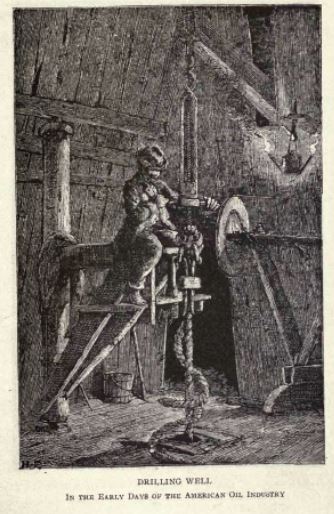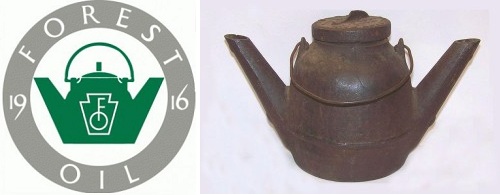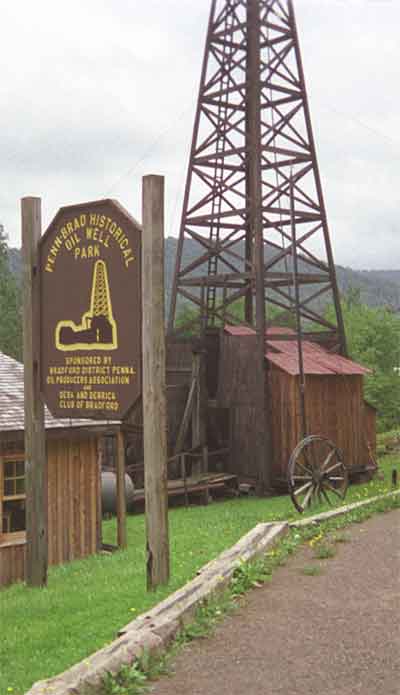This Week in Petroleum History: April 29 – May 5
April 30, 1929 – Marland Oil and Continental Oil become Conoco –
After discovering several Oklahoma oil and gas fields, Marland Oil Company acquired Continental Oil Company to create a network of service stations in 30 states. Future Oklahoma Governor Ernest W. Marland founded Marland Oil in 1921; Continental Oil Company was founded in 1875 in Utah, where it refined oil into kerosene.

After Continental Oil and Marland Oil combined in 1929, the new company used this logo until 1970.
Headquartered in Ponca City, the new company retained the name of Continental Oil, but adopted the well-known Marland red triangle trademark, replacing the “Marland Oils” text with “Conoco.” The company merged with Phillips Petroleum (first incorporated in 1917), to become ConocoPhillips in 2002.
Learn more by visiting the ConocoPhillips Petroleum Museums.
April 30, 1955 – Landmen form Trade Association
The American Association of Professional Landmen (AAPL) organized as a petroleum landmen trade association in Fort Worth, Texas. AAPL members research records to determine well ownership, locate mineral and land owners, and negotiate oil and natural gas leases, trades and contracts. With 12,000 members, AAPL assists in compliance with state and federal regulations, according to the association, which will host its 70th annual meeting this June in Boston.
May 1, 1860 – First West Virginia Oil Well
As the Civil War approached, Virginia’s petroleum industry began when John Castelli ”Cass” Rathbone completed an oil well near Burning Springs Run in what today is West Virginia. His well — drilled using a spring pole — reached 300 feet and began producing 100 barrels of oil a day.
Rathbone drilled more wells in the valley of the Little Kanawha River southwest of Parkersburg. It was the first petroleum boom to take place outside the Pennsylvania oilfields, revealed by the first U.S. well at Titusville a year earlier.
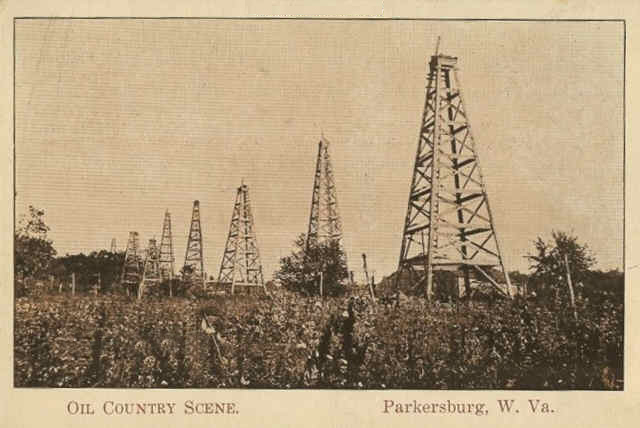
Following the 1860 oil discovery at Burning Springs, Appalachian drillers applied cable-tool technologies to drill deeper. Circa 1870 photo courtesy West Virginia Humanities Council.
By the end of 1860, the “Burning Springs Oil Rush” resulted in more than 600 oil leases registered in the Wirt County courthouse. Warehouses were built along the Little Kanawha River, which reached the Ohio River at Parkersburg.
“These events truly mark the beginnings of the oil and gas industry in the United States,” proclaimed West Virginia historian David McKain in 1994, adding that the region’s oil wealth helped bring about statehood in June 1863. Many of the new state’s politicians were “oil men — governor, senator and congressman — who had made their fortunes at Burning Springs.”
Visit West Virginia’s oil and gas museum in downtown Parkersburg.
May 1, 1916 – Harry Sinclair founds Sinclair Oil & Refining
Harry Ford Sinclair combined several depressed oil properties, five small refineries and many untested leases — all acquired at bargain prices. He began with $50 million in assets and borrowed another $20 million to form Sinclair Oil & Refining Corporation.
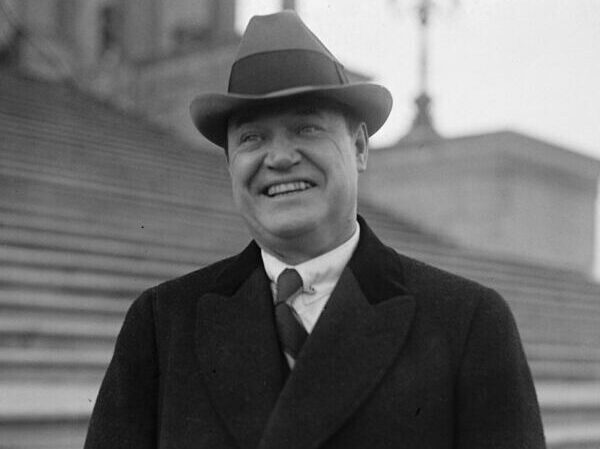
Sinclair Oil & Refining Corporation founder Harry Sinclair on the U.S. Capitol steps in January 1923. Photo Courtesy Library of Congress.
In its first 14 months, Sinclair’s New York-based company produced six million barrels of oil for a net income of almost $9 million ($258 million in 2024 dollars). The company’s petroleum refining capacity grew to 150,000 barrels of oil a day in 1932.
Sinclair was implicated in the Teapot Dome Scandal, which led to the 1929 conviction of Interior Secretary Albert Fall, but his company went on to become one of the oldest continuous names in the U.S. petroleum industry. The marketing icon Sinclair Oil dinosaur appeared as an exhibit at the 1933-1934 World’s Fair in Chicago. Sinclair died in 1956 at age 80.
May 1, 1931 – Railroad Commission limits East Texas Oil Production
The first proration order from the Texas Railroad Commission (RRC) for the giant East Texas oilfield took effect after excessive production following the Daisy Bradford No. 3 well one year earlier caused a massive collapse in oil prices. With hundreds of wells producing almost one million barrels per day, oil prices had fallen to as low as 10 cents a barrel. The commission’s order — unpopular with independent producers but enforced by Texas Rangers — limited production and stabilized prices.
May 1, 2001 – Oklahoma Plaza honors Oil Pioneers
The Conoco Oil Pioneers of Oklahoma Plaza was dedicated at the Sam Noble Museum at the University of Oklahoma, Norman. Thomas B. Slick, who discovered Oklahoma’s giant Cushing oilfield in 1912, is among those honored.

Thomas B. Slick relief at Conoco Oil Pioneers outdoor plaza at the Sam Noble Museum, University of Oklahoma, Norman.
“The history of the state of Oklahoma is inextricably linked with the remarkable history of the oil industry,” proclaimed Conoco Chairman Archie Dunham. “The individuals identified here are true Oklahoma oil pioneers in that their endeavors were most significant in the development of the oil and gas industry in this very young state.”
Learn more in Oklahoma’s King of the Wildcatters,
May 2, 1921 – Oil discovered in Texas Panhandle
Following a series of discoveries revealing the giant Hugoton natural gas field in the Texas Panhandle, a well drilled in Carson County found an oilfield instead. Gulf Oil Company completed its wildcat well on the 6666 (the “Four Sixes”) Ranch of S.B. Burnett several miles east of the natural gas wells. The discovery attracted major exploration and oilfield service companies to Amarillo. In 1926, a giant oilfield was discovered to the northeast by Asa Phillip “Ace” Borger, who founded the oil boom town of Borger. Learn more at the Hutchinson County Historical Museum.
May 3, 1870 – Lantern with Two Spouts patented
Jonathan Dillen of Petroleum Centre, Pennsylvania, received a patent for his “safety derrick lamp” — a two-wicked lantern that would become known as the “Yellow Dog” in America’s earliest oilfields. Dillen designed his device “for illuminating places out of doors, especially in and about derricks, and machinery in the oil regions, whereby explosions are more dangerous and destructive to life and property than in most other places.”
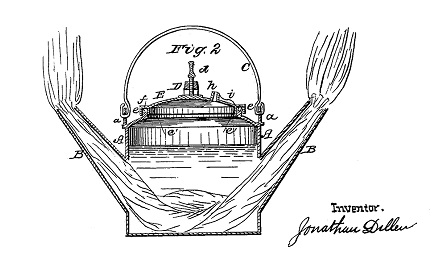
Patented in 1870, a popular two-wicked oilfield derrick lamp would become known as the “yellow dog.”
“My improved lamp is intended to burn crude petroleum as it comes from the wells fresh and gassy,” he added. How the once widely used lamp got its name has remained a mystery, but some say the two burning wicks resembled a dog’s glowing eyes at night.
Learn more in Yellow Dog – Oilfield Lantern.
May 4, 1869 – Offshore Drilling Platform Design patented
The first U.S. patent for an offshore drilling rig was issued to Thomas Rowland, owner of Continental Iron Works in Greenpoint, New York, for his “submarine drilling apparatus.” His remarkably advanced platform included a fixed, working platform for drilling in a water depth of up to 50 feet.
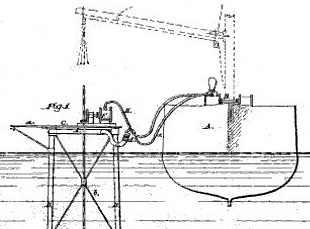
Thomas Rowland’s design for an offshore drilling platform with telescoping legs was ahead of its time.
Rowland’s anchored, four-legged tower concept would be adapted for modern platforms. His Continental Iron Works also became a world leader in gas fittings, welding, and oil tank design and construction. The American Society of Civil Engineers in 1882 issued its first Thomas Fitch Rowland Prize. which is still annually awarded.
Learn more in Offshore Rig Patent.
May 5, 1889 – Construction begins on Largest U.S. Refinery
Near Chicago, on the southern shore of Lake Michigan, Standard Oil Company began construction of a 235-acre refinery complex using advanced processes. A newly patented technology would allow the Whiting, Indiana, refinery to process sulfurous “sour crude” from Lima, Ohio, oilfields. The oil would be transported on company-controlled railroads. The giant refinery (now operated by BP) originally produced high-quality kerosene for lamps. BP completed a multi-year, multi-billion dollar modernization project at the refinery in 2013.
Learn more in Standard Oil Whiting Refinery.
May 5, 1907 – A Marker to North Texas Petroleum History
Outside Oil City (today Petrolia),Texas, the Clayco Oil & Pipe Line Company completed its Lochridge No.1 well, “site of the first gas well in Texas,” according to a granite marker that credits local rancher J.W. Lochridge for the discovery east of Wichita Falls.
“This discovery marked the beginning of intensive development of the gas industry in Texas,” the marker explains, adding that a 1901 oil well in what proved to be the Henrietta-Petrolia field had disappointed Lochridge.

Clayco Oil & Pipe Line Company commemorated its 1907 discovery in North Texas with a marker that has endured near Highway 148 south of Petrolia.
As a 2016 article in North Texas Farm & Ranch explained, “Lochridge was disappointed because he needed water for his livestock. He found a use for the oil, using it in his dipping vats to rid his cattle of parasites.”
The Clayco Oil & Pipe Line Company marker in the Henrietta-Petrolia field acknowledges Lone Star Gas Company for constructing the state’s first large-diameter natural gas pipeline in 1920 to Fort Worth and Dallas. Lone Star Gas became Enserch Corporation in 1975.
_______________
Recommended Reading: Where it All Began: The story of the people and places where the oil & gas industry began: West Virginia and southeastern Ohio (1994); “King of the Wildcatters:” The Life and Times of Tom Slick, 1883-1930
(2004). The Extraction State, A History of Natural Gas in America (2021); Erle P. Halliburton: Genius with Cement
(1959); Your Amazon purchase benefits the American Oil & Gas Historical Society. As an Amazon Associate, AOGHS earns a commission from qualifying purchases.
_______________
The American Oil & Gas Historical Society (AOGHS) preserves U.S. petroleum history. Please become an AOGHS annual supporter and help maintain this energy education website and expand historical research. For more information, contact bawells@aoghs.org. Copyright © 2024 Bruce A. Wells. All rights reserved.



